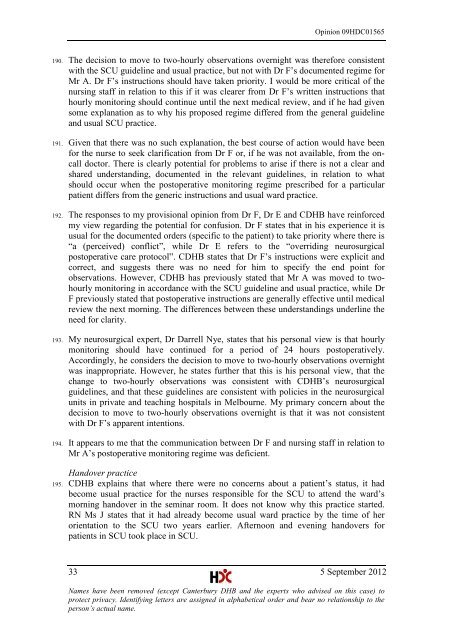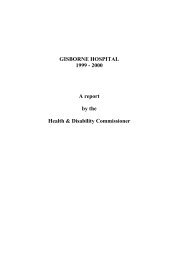09HDC01565 - Health and Disability Commissioner
09HDC01565 - Health and Disability Commissioner
09HDC01565 - Health and Disability Commissioner
You also want an ePaper? Increase the reach of your titles
YUMPU automatically turns print PDFs into web optimized ePapers that Google loves.
Opinion <strong>09HDC01565</strong><br />
190. The decision to move to two-hourly observations overnight was therefore consistent<br />
with the SCU guideline <strong>and</strong> usual practice, but not with Dr F‘s documented regime for<br />
Mr A. Dr F‘s instructions should have taken priority. I would be more critical of the<br />
nursing staff in relation to this if it was clearer from Dr F‘s written instructions that<br />
hourly monitoring should continue until the next medical review, <strong>and</strong> if he had given<br />
some explanation as to why his proposed regime differed from the general guideline<br />
<strong>and</strong> usual SCU practice.<br />
191. Given that there was no such explanation, the best course of action would have been<br />
for the nurse to seek clarification from Dr F or, if he was not available, from the oncall<br />
doctor. There is clearly potential for problems to arise if there is not a clear <strong>and</strong><br />
shared underst<strong>and</strong>ing, documented in the relevant guidelines, in relation to what<br />
should occur when the postoperative monitoring regime prescribed for a particular<br />
patient differs from the generic instructions <strong>and</strong> usual ward practice.<br />
192. The responses to my provisional opinion from Dr F, Dr E <strong>and</strong> CDHB have reinforced<br />
my view regarding the potential for confusion. Dr F states that in his experience it is<br />
usual for the documented orders (specific to the patient) to take priority where there is<br />
―a (perceived) conflict‖, while Dr E refers to the ―overriding neurosurgical<br />
postoperative care protocol‖. CDHB states that Dr F‘s instructions were explicit <strong>and</strong><br />
correct, <strong>and</strong> suggests there was no need for him to specify the end point for<br />
observations. However, CDHB has previously stated that Mr A was moved to twohourly<br />
monitoring in accordance with the SCU guideline <strong>and</strong> usual practice, while Dr<br />
F previously stated that postoperative instructions are generally effective until medical<br />
review the next morning. The differences between these underst<strong>and</strong>ings underline the<br />
need for clarity.<br />
193. My neurosurgical expert, Dr Darrell Nye, states that his personal view is that hourly<br />
monitoring should have continued for a period of 24 hours postoperatively.<br />
Accordingly, he considers the decision to move to two-hourly observations overnight<br />
was inappropriate. However, he states further that this is his personal view, that the<br />
change to two-hourly observations was consistent with CDHB‘s neurosurgical<br />
guidelines, <strong>and</strong> that these guidelines are consistent with policies in the neurosurgical<br />
units in private <strong>and</strong> teaching hospitals in Melbourne. My primary concern about the<br />
decision to move to two-hourly observations overnight is that it was not consistent<br />
with Dr F‘s apparent intentions.<br />
194. It appears to me that the communication between Dr F <strong>and</strong> nursing staff in relation to<br />
Mr A‘s postoperative monitoring regime was deficient.<br />
H<strong>and</strong>over practice<br />
195. CDHB explains that where there were no concerns about a patient‘s status, it had<br />
become usual practice for the nurses responsible for the SCU to attend the ward‘s<br />
morning h<strong>and</strong>over in the seminar room. It does not know why this practice started.<br />
RN Ms J states that it had already become usual ward practice by the time of her<br />
orientation to the SCU two years earlier. Afternoon <strong>and</strong> evening h<strong>and</strong>overs for<br />
patients in SCU took place in SCU.<br />
33 5 September 2012<br />
Names have been removed (except Canterbury DHB <strong>and</strong> the experts who advised on this case) to<br />
protect privacy. Identifying letters are assigned in alphabetical order <strong>and</strong> bear no relationship to the<br />
person’s actual name.
















